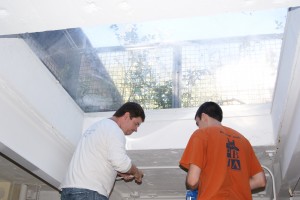Q-lon is foam weatherstripping in the shape of a V attached to a wooden or metal slat. The V expands to fill any open space between the doorjamb and the door—a lot like the V-channel weatherstripping that we use for our windows. When I found out about the Q-lon last time, I still didn’t know quite how to install it, so I was glad to get the chance. HEET actually has a really good tutorial that walks you through the basics. The most important part is making sure the foam isn’t too compressed or too slack. You do this by sliding a piece of paper between the weatherstripping and the (locked) door. If the paper doesn’t fall out when you let go, it’s tight enough. If it comes out when you pull on it, it’s loose enough.
I’m especially interested in this because the self-adhesive foam weatherstripping that we used last year compressed a lot. I don’t know how effective it is anymore. Since the Q-lon is installed on a different part of the doorjamb, we can keep the foam and just add this to it. It’s a much more permanent solution.
It does require some hacksawing, though, to cut the slats down to the size of your door. This may have been the first time I’ve ever used a hacksaw in my life, and I’m proud to say that I got the hang of it after just a couple of ragged edges.
Jason got to use spray foam on the cracks around the skylights. This is only the second time he’s used it, and he picked up some tips. First, wear goggles and gloves, and hold something under the can so it won’t drip anywhere. That stuff never comes out. Second, shake it for a long time, then spray it into a trash can until you get a sense of how fast it comes out. It can expand like crazy. You can cut it down with a razor blade once it’s dry, but it’s easier to not have to. Make sure you have a lot of cracks to fill, though—once you start the can you can’t store it to use again later.I’ve really enjoyed these weatherizations, and I’d definitely do another. I like the idea that the energy savings that the homeowners see will be multiplied by the skills the volunteers learn to use in our own homes. And it’s nice to meet like-minded neighbors (even the crazy ones).
Cross-posted on pragmaticenvironmentalism.com


Pingback: Pragmatic Environmentalism